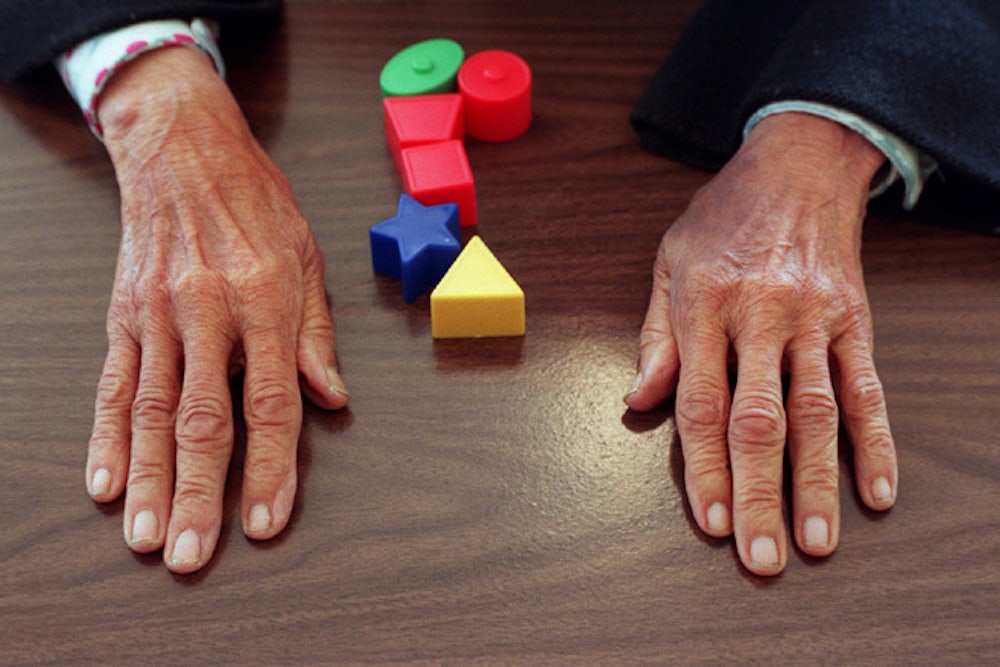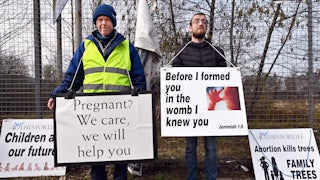It was 15 below, one morning in early February, when Lorraine Wildcat, 61, woke at 4 a.m. in her mother’s house in Lac du Flambeau, Wisconsin. That hour of the morning was Lorraine’s quiet time, the lone hour for herself in a workday that stretched 23 hours, including being on call when she’s asleep. She used it to look out at Lake Moss—frozen, along with the 260 other lakes of the reservation—over a cup of coffee.
She started to think ahead to the drive she’d embark on later that morning to take her mother, Rosetta, 88, to the post office, winding through 20 miles of frosted evergreens—Rosetta’s favorite part of day. But first: Set Quaker’s Fruit and Cream oatmeal on the kitchen table, guide Rosetta’s feet into shoes, and point the medication into her mouth, since she’s forgotten how to take it. Then turn the TV to The Price is Right or an old video of Johnny Cash to calm Rosetta’s tangled mind.
“Good morning, Mom, I love you,” Lorraine greeted Rosetta when she woke up. Rosetta replied, “I love you more!” with a smile. Then the watching began, the full-day shift, to make sure Rosetta doesn’t wander off into the winter.
Alzheimer’s is on the rise across all Americans over 65, with one in nine people in that age cohort now living with the disease, a total of over six million people. But for American Indian and Alaska Native populations—who are more predisposed to Alzheimer’s and dementia than White and Asian populations—Alzheimer’s is growing exponentially, with at least one in three elders predicted to develop the disease.
Faced with the cost of 24-hour at-home care—which can quickly plummet families into debt—or $7,000 per month for a private nursing home, 16 million Americans, like Lorraine, have chosen to become Alzheimer’s caregivers themselves. According to the Centers for Disease Control and Prevention, one in three American Native adults is now a caregiver, providing regular care or assistance to a friend or family member with a health problem or disability.
The reason is simple: Medicare doesn’t cover the cost of long-term support like an in-home aide, and Medicaid is overrun with nearly a million people on waitlists for home and community-based services. The United States is the only industrialized nation without a national paid family leave policy; for 6.6 million Americans, the reason they have left the workforce is to care for another person.
“It was very hard; I loved my job,” Lorraine said. She left her adult life in Chicago to move back in with Rosetta—who could not operate a phone or call 911 as her Alzheimer’s worsened—on the reservation. “My bills weren’t used to the cut, either,” Lorraine said. “Now I’m behind every month.” Still, “I would choose my parents over everything.”
Alzheimer’s is rising in Indian Country in part due to increased life expectancy, says J. Neil Henderson, professor emeritus at the Department of Family Medicine and Biobehavioral Health at the University of Minnesota Medical School in Duluth. Henderson, whose tribal affiliation is Oklahoma Choctaw, spearheaded the Memory Keepers Medical Discovery Team, a research unit studying dementia in American Indian and rural populations, to address severe health disparities.
Thirty years ago, “a lot of Native people would not have lived into the ages of greatest risk,” over 65 and into their eighties, he said. Age is the main risk factor, but another is type 2 diabetes, which affects American Indians at double the rate of the general population. Too much sugar in the bloodstream, for too long, causes toxic waste to build in the brain, contributing to the death of brain cells. And when that happens over a long period, it’s called dementia, Henderson said.
According to the Alzheimer’s Association, one in five American Indians over age 45 displays what could be signs of dementia. A new study from the University of Wisconsin estimates the cost of Alzheimer’s in Indian Country is somewhere between $880 million to $1.9 billion annually.
Alzheimer’s is so new to the public consciousness in Indian Country that for many tribes there is not a word for dementia. The few studies that do exist undercount its prevalence and cost, slowing access to care, said Adrienne Johnson of the University of Wisconsin School of Medicine and Public Health. Misdiagnosis runs rampant with Alzheimer’s generally, with 50 to 70 percent of symptomatic patients not recognized or correctly diagnosed in primary care.
Diagnoses are even fewer in Indian Country, Johnson said. “Who is the president of the United States?” might be a question on the Mini-Mental State Examination, a standard assessment for dementia. But to Henderson, a better question might be, “Who is the chief of your tribe?” or, “What is the growing season for a particular type of vegetable?” One reason for misdiagnosis is cognitive assessments that don’t reflect American Indian culture or life experience.
Part of the problem is an underfunded Indian Health Service, or IHS, the agency within the Department of Health and Human Services responsible for providing federal health services to Indian Country, said Brian Vallo, who was governor of Acoma Pueblo in New Mexico—the oldest continuously inhabited community in North America—from 2019 to 2021.
Vallo watched his grandmother slowly lose her capacity for high-stakes Bingo and eventually need 24/7 care. But his eyes opened to the severity of the problem when he became governor of his tribe and had the authority to access IHS data that left him “sickened.” There was negligence in the agency’s capacity to address Alzheimer’s and other diseases, he said. The slow response was causing loss of life.
In Vallo’s grandmother’s case, it took eight months for a dementia diagnosis to return from IHS. It was almost a year after her first hospitalization for severe confusion before she received treatment, during which time she experienced two more episodes and declined considerably. A typical IHS timeline for securing evaluations and approvals can last a year, Vallo said. “It was very evident that the Indian Health Services [were] far behind—because of lack of funding from the federal government—in their knowledge of this disease in Indian Country. And they still are.”
Most American Indian families care for seniors at home, out of deep reverence for elders and a distrust of nursing facilities. But people are not born knowing how to take care of an adult with a brain disease, Henderson said. He conducts trainings—the “Savvy Caregiver in Indian Country”—outlining each Alzheimer’s stage with strategies, since the job continually changes. Without a cure, “the caregiver remains the best medicine” for the disease.
The word caregiving might bring to mind new parents—the ragged, sleepless nights of guessing basic needs for the helpless new arrival. But then the routine settles, sleep lengthens. Independence slowly comes.
For families with Alzheimer’s, the routine does not settle. They too care for relatives who can’t walk, talk, bathe, dress, or eat alone, but for them, the routine grows more complex, both physically and emotionally. The sense of high alert does not end. Confrontations increase. You grieve the person while they’re still alive.
What’s most needed is a break, a chance to recover from sleep deprivation, emotional exhaustion, depression, and chronic health conditions worsened by missed doctors’ appointments. The best medication for the caregiver, Henderson said, is respite care each week, where another caregiver takes over.
There are some private efforts to fill the gap. The actors Lauren Miller Rogen and her husband, Seth Rogen, have raised $20 million to provide in-home care relief to families impacted by Alzheimer’s disease, through their nonprofit Hilarity for Charity, or HFC. “No matter where you live, or how much money you make, you will be a caregiver, or need care,” Miller Rogen told me, relaying the story of watching her mother overtaken by early-onset dementia at 55 and eventually requiring 24/7 care for the last six years of her life.
She’s focused HFC’s fundraising less on research—which receives considerable public and private support—and more on the immediate, day-to-day, years-long agony of caregiving, which is felt by millions but often overshadowed by the search for a cure. Lorraine was one of 28 caregivers in Indian Country to receive a grant from HFC and the International Association for Indigenous Aging during the pandemic. Soaring Eagles Home Care helped coordinate in-home hours; Walmart gift cards replenished caregivers’ groceries and gas.
But private money can only go so far. “The truth is, we shouldn’t be doing it, the government should be doing it,” Miller Rogen said. That’s not an uncommon view. Nearly 90 percent of likely voters support increasing government funding for home and community-based services, to allow seniors and people with disabilities to live independently and receive care in their homes. Eight in 10 support guaranteeing paid family and medical leave for workers to take time off to care for a family member. President Biden referenced care more than 10 times in his State of the Union speech; new legislation is on deck, including the FAMILY Act, the HCBS Access Act, and the Better Care, Better Jobs Bill.
But it’s unlikely any of those bills will become law under a divided Congress, and there’s a time element, especially in Indian Country. American Indian elders are held in high cultural esteem as protectors, mentors, keepers of wisdom and memories. What happens when Alzheimer’s comes for those memories?
On the land where Rosetta now lives, the Lake Superior Band of Chippewa Indians have resided since 1745. French fur traders gave it its name—lake of torches—after spying Ojibwe men spearfishing at night, in torchlit canoes. The reservation was established in 1854. The following year, the government decided to log it. The trees came down in Lac du Flambeau: 40 million feet of boards over two winters. A century later, in the 1950s, the Bureau of Indian Affairs decided that there was an “Indian problem” in the U.S. and sought to remove American Indians, like Rosetta, from rural reservations and relocate them to cities, including Chicago, where Lorraine was born.
“As the older population walks on, there will be a loss,” Henderson said, “of language, of nuance, of cultural understandings of the world.”
“There will be fewer people who had the experience of extreme discrimination and what it was like in the United States, even in the 1950s, with regard to Native people,” he continued. “It’s a pretty bad record that has not been very well corrected.”
Rosetta returned to the reservation in 1964, four years after her family’s relocation, and has lived in her family home for 50 years now. At 81, she started to show signs of forgetfulness. At 88, she’ll try to point something out on the daily drive to the post office—a memory of Flambeau—but not finding the words, returns to the topic of the trees, how big they’ve grown. These are the conversations now between mother and daughter.
Have a plan in place for people to help you, Lorraine advises Alzheimer’s caregivers. Her Lac du Flambeau neighbors and friends have cared for parents and husbands who’ve now passed. She loves climbing into the car with Rosetta each day, the crunch of snow underfoot. But it’s not easy going it alone.


